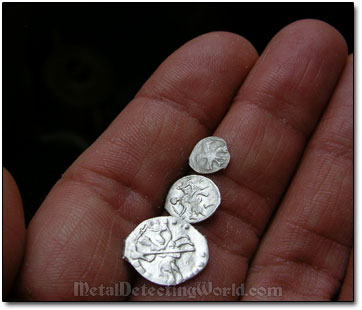Metal Detect Hammered Wire Coins: Useful and Practical Information
Coin Descriptions, Brief Numismatic History, Search and Recovery Methods, Real Stories

Introduction
Out of all types of non-ferrous hammered coins, the "wire money" type hammereds are the hardest to metal detect due to their tiny sizes and low-conductive properties. That is why, at hunt sites of the former medieval and late-medieval settlements in Eastern Europe, these thin-sectioned hammies are the "last ones to go" among other coins and artifacts being detected and recovered. Usually the hammered coins are left behind by inexperienced or impatient coin shooters and those who use incapable metal detectors.
Most of today's advanced metal detectors are capable of detecting the wire coins lying flat on ground surface. Division of regular "land" metal detectors into two subcategories - 'capable' and 'incapable', begins when the wire coins happen to be in less detectable positions in the ground and/or, most crucial, audio responses to the coins are affected by iron masking. The latter "kicks" most of detectors, including the multi-frequency ones, out of competition. On today's market, only the high-frequency metal detectors with high Reactivity and adjustable audio tones substituting Discrimination can get the most of the wire coins out of the "hunted-out" sites.
When most metal detectors stop "picking up" any non-ferrous signals or questionable signals of the "coin+nail" type at the iron-infested settlement site, the site is considered "searched-out". But when skilful detectorists with capable high-frequency machines arrive at the "hunted-out" location, they easily find numerous wire coins and small non-ferrous artifacts. And the hunt site becomes "fruitful" again!
The following are three reasons why the wire-coin hunting has recently become popular among Eastern European and Scandinavian coin shooters: 1) elusiveness of the hammered wire coins makes their detection a challenge and, therefore, more interesting than a regular coin shooting, 2) the wire coins' presence at the "thought-to-be-expended" detecting sites attracts skillful and persistent coin shooters with advanced metal detectors that "revive" these sites providing more metal detecting fun to their operators, 3) tricky nature of the wire-coin hunting process gives a detectorist an opportunity to improve personal coin-detecting and coin-recovery skills, and, therefore, achieve a higher level of excellence, and 4) as the easy-to-research and easy-to-get-to "coin-saturated" hunt sites have become scarce, more and more detectorists have been compelled by new metal detecting conditions to get into the wire money detecting in order to continue pursuing their favorite hobby. In simple words, the wire-money hunting brings a new thrill to the process of coin shooting or metal detecting in general.
TABLE of Contents:
1) Brief Info on Early Russian Hammered Coins - "Wire Money"
2) Brief Description of Wire Coin Production Method
3) Optimal Ground Surface Conditions for Detecting Tiny Hammereds
4) Search Coil Discipline and My Recovery Techniques for Retrieving Single Hammered Wire Coins
6) Photo Gallery of Early Russian Wire Money also includes some numismatic information.
7) How To Identify and Interpret Cyrillic Dates on Russian Coins of Peter I The Great - Tutorial for coin collectors.
